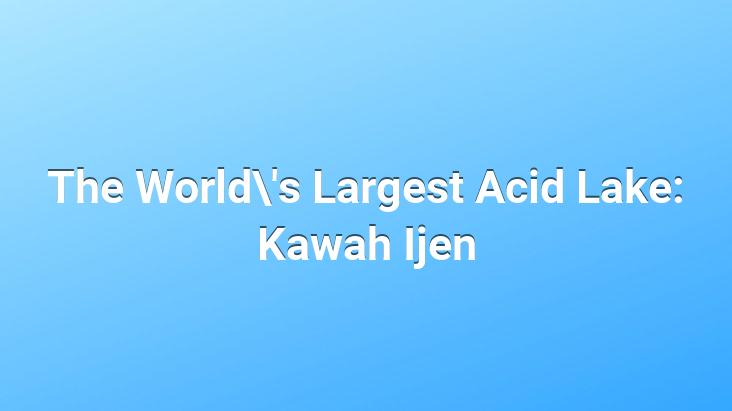After breakfast in Probolinggo, we set out to see Kawah Ijen volcano. I always say, but I will say it again; We have passed many beautiful roads.. The roads that pass through the rain forests, among the banana and coconut trees, and then pass by the coffee gardens of millions of hectares, rising from place to place, very broken and winding, but offering an incredibly pleasant and delicious view.. Here are the roads that make people say, “This is the way to be on the road.”. In this area where Kawah Ijen Volcano is located, everywhere is covered with coffee trees.. It was getting dark when we reached the climbing point in Kawah Ijen.. The nightly fees of the hotels here exceed Rp 500,000.
If I remind you that we pay Rp 200,000 per night to many quality hotels, it is remarkable that the price is more than twice as much.. We stopped staying here and visited the villages on the way and searched for a place to stay.
Since we could not find a place to stay in many villages, we moved to Sempol village.. We got a place at the biggest hotel here, but when Johny told me that his aunt lives in the nearby village, we decided to visit them first.. Johnny last came here with his mother when he was 4 years old.. He searched and found the house.. They welcomed us with smiling faces and instead of staying at the hotel, we were guests at Johny’s relatives’ house tonight.
The whole village works in coffee gardens.. Including the area on which the village is located, 1 million hectares of land belonged to a Dutch person.. Formerly Indonesia was a Dutch colony and all resources and production were controlled by the Dutch government.
Now the landowners are rich Dutch or foreigners, the peasants still work in these gardens with the same poverty.. The coffee produced is considered among the best quality coffees in the world.. We were also offered coffee produced in the village.. Various dishes were prepared. All meals are sourced from the wood-fired stove in the kitchen at the back of the house.. These wood stoves are used for cooking and water heating in most rural areas and village houses.. The use of tube stoves is common in cities and some towns.
None of the houses have toilets and bathrooms.. The stream passing through the village was used as a natural toilet area.. Two separate cabins built right next to the creek are set as places where the villagers take a bath separately, but together, for men and women.. No doors, no curtains, no high walls, so it’s for the public. Literally “public” toilet and bathroom. The spring water, on the other hand, is cold and comes from the mountain.
After the meal, my fellow traveler Farid excitedly called me, saying grab the camera and come with me right away, you won’t believe what you see.. This was the public bathroom we had reached when I put on sandals and ran after him.. Inside, the workers who had returned from their jobs in the coffee gardens were taking a shower and were naked!
After dinner, Farid, Johny and I drank our coffees and took a shower in this area, as the villagers do.. We had traveled hundreds of kilometers by motorcycle.. We were already covered in dust as most of the roads were broken and dusty.. When you first touch the water coming from the mountain and the water first touches your skin, you feel like it is icy.. But then, interestingly, that coldness went away and was replaced by a sweet warmness.. Especially after drying, we felt as light as a feather.
We got up at 4 am the next morning and ate the cookies and rice pilaf prepared for breakfast for breakfast.. It is necessary to get up earlier to see the sunrise, but since our aim is only to see Kawah Ijen, we only started climbing the mountain around 6 o’clock.
The climbing strip is not very difficult.. It is very beautiful and has a wide and clean path through the trees. Some parts are very steep and some parts are almost horizontal.. While we were climbing, some sulfur carriers filled their baskets with the sulfur they extracted from the mouth of the volcano and were walking towards the place where they were saved to sell to the factory.. They are all thin, but the weight of the sulfur they carry varies between 40 and 80 kg.. Some of them could carry up to 360 kg of sulfur per day.
It is difficult to understand how these small carriers, some of whom are close to 70, manage to do this.. They get Rp 500 per kilo of sulfur they carry. In other words, a worker carrying 60 kg of sulfur earns 6 TL, excluding taxes, as he completes his duty.
To get sulfur from the village, it takes about 4 hours to go to Kawah Ijen’s mouth and fill their baskets with sulfur and reach the factory. In other words, an hourly wage is simply 2 TL. they earn below. On the other hand, a cup of coffee grown from the coffee trees nearby starts from 5 € in Europe.. What an irony, isn’t it! I guess “marketing” means everything in the modern world.
We reached the top by chatting with the porters we met, taking photos and resting in front of the fascinating landscapes, meeting and chatting with other travelers who climbed the volcano like us.. I think it took an hour and a half.. Inside the crater, there is the lake and next to it, the mouth of the volcano that releases sulfur gas with all its might.
The mouth of this volcano is channeled with barrels and the molten sulfides are collected in one place, and the sulphides taken from there are cooled, crushed, filled into bamboo baskets and transported to the village.. From here, it is collected and sent to the factory in Banyuwangi.. This sulfur was used to obtain refined sugar and to manufacture rubber.
Normally, there is a sign stating that it is forbidden to go down, but no one is listening, of course.. Some porters offer you guidance. A place to land comfortably without the need for a guide. So we had to go down and breathe that toxic sulfur fumes into our lungs.. The water of the crater lake is so hot that it almost burns your hand.. When sulfur is poisonous, the water is also poisonous and no fish can live in it.
Kawah Ijen, called the Green Crater, is an active volcano at a height of 2,600 meters.. The depth of the turquoise crater lake right next to the mouth of the volcano reaches 212 meters and the lake contains the strongest acid in the world, a mixture of 36 million cubic meters of sulfuric acid and hydrogen chloride, together with rain water.. The temperature of this liquid is 34 degrees Celsius. Up to 4 tons of sulfur gas is released every day by volcanic gas eruptions.
My crazy adventurer friend Farid made a deal with a carrier and borrowed a basket from him.. He filled it with 20 kg of sulfur and started walking back to the village.. At first I thought it would just carry it from the mouth of the crater to the top of the hill, but with patience and perseverance, he carried all those roads to the graft village.
Just for fun, I mean.. Both the porters and other travelers passing by were watching us in amazement.. Interestingly, it seemed to me that the descent path was longer than the climbing path.
When we left the crater mouth and reached the edge of the crater, the sulfur clouds, which had previously blown in the opposite direction to the climbing and viewing area, were spreading in all directions, with the effect of the wind.. From that moment on, being there is risky for health and does not allow you to see anything.
Therefore, those who aim to visit this place are recommended to set off early in the morning and finish their visit before 9 am.. When you accidentally inhale the sulfur at the mouth of the volcano, your breathing stops completely and tears begin to come from your eyes immediately.. This is followed by cough.. The eyes of the sulfur workers working there were bloodshot.
After resting for half an hour, we hit the road again.. We are now returning to the city of Banyuwangi, the starting point of our visit.. The way back is so awful that it might be called one of the worst roads you’ll ever see in your life.. After the visit, as Jeeps, tourist minibuses and motorcyclists, we crossed that road, jumping and jumping, on motorcycles and sometimes on foot.. He said that in this forest area to our right and left, there are 4 monkey species, gray, white, black and orange.. Although I looked for a long time, I could only see 1 gray monkey.. An easy and pleasant way for those who think about trekking. Those who have time may think about it.
After crossing this 5-7 kilometer bad part of the road from Kawah Ijen with great difficulty, we finally reached the smooth roads.. Even one-lane road works were continuing.. After more than two hours, we passed through the beautiful roads as usual and arrived in Banyuwangi in the afternoon.. The first thing we did was to take a shower, eat our dinner and sleep.
We covered 1,100 km on our motorcycle trip for eight nights and 9 days.. Actually, our trip is not over and tomorrow our day trip to Baluran National Park will finally come to an end.. I can easily say that; If I had the opportunity and time to write about the fascinating geographical places I saw in these 9 days, the interesting events I witnessed, and the experiences of people from different languages and cultures I met, I am sure that a book would come out.. Maybe one day if I can find time to travel…
Day 380: ID:37, Banyuwangi, Java. Friday, 18-19 August 2011







